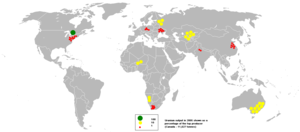Uranium mining
Uranium mining takes uranium ore from the ground for processing. Kazakhstan, Canada, and Australia are the top three producers and together account for 64% of world uranium production. Uranium from mining is mostly used as fuel for nuclear power plants. Health and environmental studies show that radiation exposure poses a risk for uranium miners. In 1990, Congress passed legislation to help those affected by mining. As of July 2014, the price of uranium concentrate remained near a five-year low, the uranium price having fallen more than 50% from the peak price in January 2011, and reflecting loss of demand following the 2011 Fukushima nuclear disaster. Some plans for new mines and mine expansion have been deferred.


Background
changeThe worldwide production of uranium in 2012 amounted to 58,000 tonnes. Kazakhstan, Canada, and Australia are the top three producers and together account for 64% of world uranium production. Other important uranium producing countries are Niger, Namibia, Russia, Uzbekistan, the United States, China, and Malawi.[1]
Uranium from mining is mostly used as fuel for nuclear power plants. Uranium ores are normally processed by grinding the ore materials to a uniform particle size and then treating the ore to extract the uranium by chemical leaching. The milling process commonly yields dry powder consisting of natural uranium, "yellowcake," which is sold on the uranium market as U3O8.
Environment
changeIn 1950, the US Public Health service began a comprehensive study of uranium miners, leading to the first publication of a statistical correlation between cancer and uranium mining, released in 1962.[2] The federal government eventually regulated the standard amount of radon in mines, setting the level at 0.3 WL on January 1, 1969.[3]
Out of 50 present and former uranium milling sites in 12 states, 24 have been abandoned, and are the responsibility of the US Department of Energy.[4] Accidental releases from uranium mills include the 1979 Church Rock uranium mill spill in New Mexico, called the largest accident of nuclear-related waste in US history, and the 1986 Sequoyah Corporation Fuels Release in Oklahoma.[5]
In 1990, Congress passed the Radiation Exposure Compensation Act (RECA), granting reparations for those affected by mining, with amendments passed in 2000 to address criticisms with the original act.[2]
Economics
changeAs of July 2014, the price of uranium concentrate remained near a five-year low, the uranium price having fallen more than 50% from the peak price in January 2011, and reflecting loss of Japanese demand following the 2011 Fukushima nuclear disaster.[6] Because of continued low prices, in February 2014 mining company Cameco put back plans to expand production from existing Canadian mines, although it continued work to open a new mine at Cigar Lake.[7] Also in February 2014, Paladin energy suspended operations at its mine in Malawi, saying that the high-cost operation was losing money at current prices.[8]
Its effect upon the Earth
change238U produces ~40% of the radioactive heat produced within the Earth.[9] The decay of 238U to daughter isotopes is extensively used in radiometric dating, particularly for material older than ~1 million years.
References
change- ↑ 1.0 1.1 "World Uranium Mining Production". World Nuclear Association. Archived from the original on 2014-06-13. Retrieved 2014-05-15.
- ↑ 2.0 2.1 Dawson, Susan E, and Gary E Madsen. "Uranium Mine Workers, Atomic Downwinders, and the Radiation Exposure Compensation Act." In Half Lives & Half-Truths: Confronting the Radioactive Legacies of the Cold War, 117-143. Santa Fe: School For Advanced Research, 2007)
- ↑ Brugge, Doug, Timothy Benally, and Esther Yazzie-Lewis. The Navajo People and Uranium Mining. Albuquerque : University of New Mexico Press, 2006.
- ↑ Decommissioning of U.S. Uranium Production Facilities
- ↑ Doug Brugge, et al, "The Sequoyah Corporation Fuels Release and the Church Rock Spill", American Journal of Public Health, September 2007, Vol., 97, No. 9, pp. 1595-1600.
- ↑ Cameco, Uranium 5-year spot price history Archived 2014-09-07 at the Wayback Machine, accessed 7 Sept. 2014.
- ↑ Nickel, Rod (7 February 2014). "Uranium producer Cameco scraps production target". Reuters. Archived from the original on 24 September 2015. Retrieved 17 April 2014.
- ↑ Komnenic, Ana (7 February 2014). "Paladin Energy suspends production at Malawi uranium mine". Mining.com. Retrieved 17 April 2014.
- ↑ Arevalo, Ricardo; McDonough, William F.; Luong, Mario (2009). "The K-U ratio of the silicate Earth: Insights into mantle composition, structure and thermal evolution". Earth and Planetary Science Letters. 278 (3–4): 361–369. Bibcode:2009E&PSL.278..361A. doi:10.1016/j.epsl.2008.12.023.